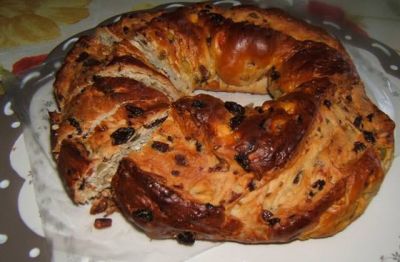The Torcolo di San Costanzo is a rich raisin, pinon and citron-ladened sweet bread created in honor of San Costanzo, one of the patron saints of Perugia, Italy. Executed on January 29 during the reign of Marcus Aurelius, his memory is celebrated every year in Perugia with various festivities, one of them being a competition amongst the various bakeries of Perugia for the best Torcolo. It is also traditional for a man to give this bread to his lover and if the statue of San Costanzo winks at you on the day the bread is presented, the couple will marry within a year. Always available in the Perugia bakeries, it is a delectable treat any day of the year, warmed for breakfast or as a spuntino (snack), spread with mascarpone. This recipe was shared with me by my friend, Christine Hickman, an excellent chef and cooking teacher.
Ingredients (makes 1 large loaf):
- ½ C. Golden raisins
- ½ C. Warm water
- 1 C. Warm milk
- 1 T. Active dry yeast
- 4 T. Unsalted butter, melted and cooled
- 4 T. Extra-virgin olive oil
- 2/3 C. Sugar
- 3 Large eggs, lightly beaten
- ½ tsp. Salt
- ½ C. Finely chopped citron
- ½ C. Finely chopped candied orange peel
- ½ C. Toasted pine nuts
- 1½ T. Anise seed
- Finely grated zest of 2 lemons
- 5-6 C. Unbleached all-purpose flour or high-gluten bread flour
- 1 Egg yolk, lightly beaten, for glaze
Directions:
Place the raisins in a small bowl, cover with warm water, and let soak 30 minutes. In another small bowl, whisk the yeast into the warm milk and set aside about 10 minutes, until bubbles begin to rise to the surface. Pour the yeast mixture into the bowl of a standing mixer fitted with the paddle attachment and, on low speed, blend in the butter, olive oil, sugar, beaten eggs, salt, citron, orange peel, pine nuts, anise seed, lemon zest, and raisins along with their soaking liquid. Add the flour on low speed, one cup at a time, blending well after each addition. When a thick paste begins to form, switch to the dough hook and continue adding the flour until the dough begins to pull away from the sides of the mixing bowl. It will feel slightly tacky to the touch. Continue to knead the dough 3 more minutes on medium speed. Remove the dough from the bowl to a lightly floured surface and knead it with your hands several times until it is smooth and elastic. Form it into a ball, place the dough in a lightly-oiled bowl and cover with plastic wrap. Let it rise until doubled, about 2 to 3 hours. *If mixing by hand, once all the ingredients have been incorporated knead the dough by hand on a lightly floured surface 10-12 minutes, until it is smooth and elastic. Punch the dough down with your fist. Transfer it to a work surface and roll it into a rope 24-inches in length. Set the dough onto a parchment-lined baking sheet, connect the ends to make a circle, pinch them together tightly to seal, cover with a towel and let rise until doubled, about 1½ to 2 hours. Thirty minutes before you plan to bake, set baking stones (if available) inside the oven on the lower shelf and preheat to 400° F. If not using baking stones, adjust the oven rack to the lower third of the oven.
Just before baking, make 5 slashes along the top of the dough parallel to the outside edge, and open the cuts well. Brush the loaf with the beaten egg yolk to give it a shiny gloss. Bake 30 minutes, turn the heat down to 375° F and bake 10 minutes longer. If the top gets too brown, cover it with aluminum foil. The bread is done when it sounds hollow when lightly tapped on the bottom. Transfer the bread to a cooling rack and allow to cool to room temperature before serving. May be frozen, wrapped tightly in plastic wrap, for up to 1 month.
Buon appetito!



